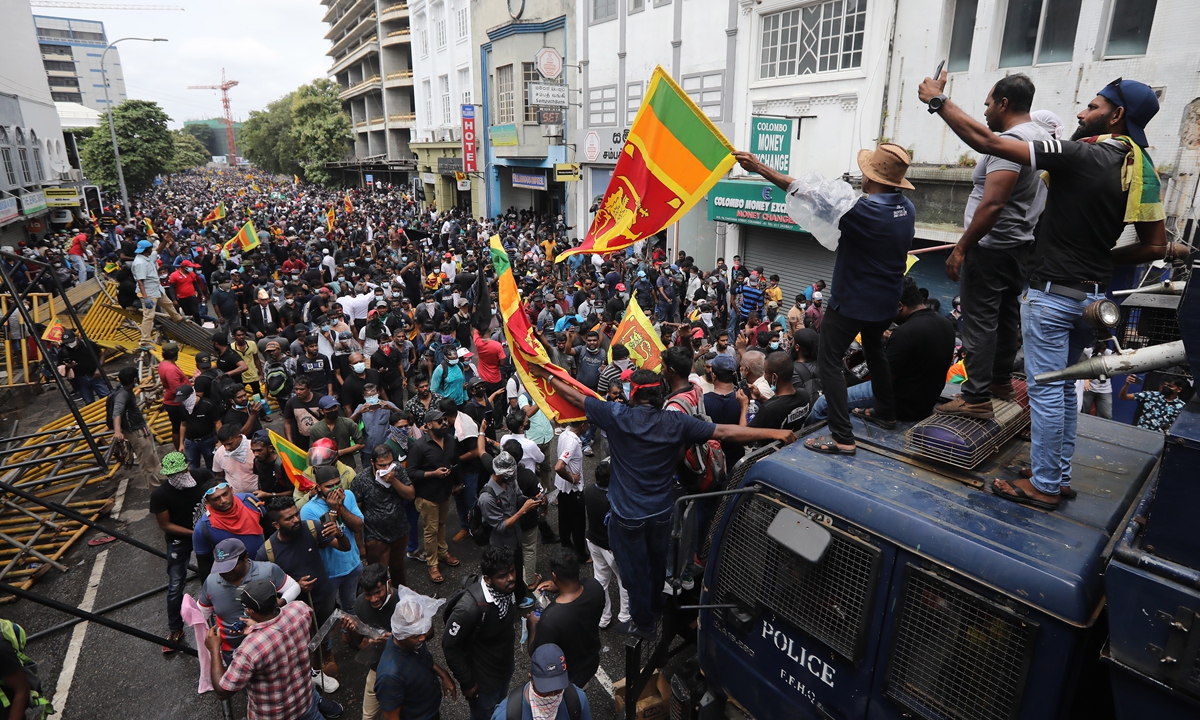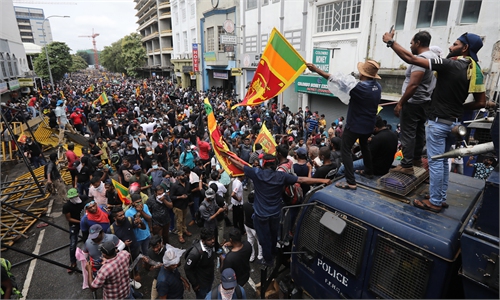Sri Lankan president, prime minister to resign after protesters stormed their houses and offices
Chinese nationals, firms remain safe despite turmoil, urged to stay vigilant

Protesters gather near the presidential palace in Colombo, Sri Lanka on July 9, 2022. Photo: IC
Sri Lanka's economic crisis has become a political one as both the country's president and prime minister agreed to resign Saturday after protesters stormed the official residences of the two leaders, setting fire to the prime minister's residence. Experts believe the country's crisis is a result of both internal and external troubles, including galloping inflation, its economic system, and the onslaught of COVID-19.
As the capital Colombo descended into chaos, many foreign media, especially Indian media, increased their efforts to throw mud at China by hyping "Chinese debt trap diplomacy" in Sri Lanka. The most jaw-dropping rhetoric is the accusation that it caused the current economic crisis in the South Asian country. Experts believe these tricks have long been used by green-eyed Indian politicians who want to remove China's influence from the region, and experts warned such hype will do nothing to help the country in crisis, but only add fuel to the fire.
Sri Lankan President Gotabaya Rajapaksa on Saturday informed the country's parliament speaker Mahinda Yapa Abeywardena that he will resign from office on July 13, the Xinhua News Agency reported on Sunday.
The speaker's office told Xinhua that the president made the decision following a request by political party leaders. Prime Minister Ranil Wickremesinghe also agreed to resign earlier in the day after party leaders in the parliament urged both him and the president to step down, according to Xinhua.
On Saturday, protesters stormed the president's residence and office, and the prime minister's residence was set on fire, Xinhua reported.
Sri Lanka's opposition political parties were meeting Sunday to agree on a new government, Associated Press reported.
Approaching the president's official residence at Sunday noon, a Global Times reporter based in Colombo saw large groups of protesters and civilians had swarmed into the residence. Protesters posted photos of them lying on beds, working out in the gym and swimming in the swimming pool. Some protesters mimicked politicians having meetings in meeting rooms.
There were a large number of military personnel and police outside the residence, and one of the police officers told the Global Times that people are coming and going as they please. The in-house facilities in the residence were damaged to a certain extent, said the officer, although he said that the situation is relatively safe.
The protest is fueled by economic turmoil which has plunged the Indian Ocean island nation of 22 million into a crisis, leaving many struggling to buy food, medicine and fuel, according to some analysts.
The Chinese Embassy in Sri Lanka on Saturday reminded Chinese nationals not to participate in or watch any protests. It urged Chinese nationals in Sri Lanka to pay close attention to the local security situation and abide by local laws and regulations, after the protests had caused multiple injuries.
Yang Shiyuan, chief media officer at the Chinese Chamber of Commerce in Sri Lanka, told the Global Times over the weekend that both Chinese personnel and Chinese-funded projects are so far unaffected.
A person with a large state-owned energy infrastructure company told the Global Times on Sunday that with warnings from the Chinese Embassy, their staff are all well behaved and disciplined. "There are no problems with the safety of personnel and projects here," the person said in Sri Lanka.
"Enterprises here are basically at a standstill due to the lack of electricity and oil, but we're safe now despite the protests," Zhang Xudong, president of Sri Lanka Overseas Chinese Association, told the Global Times on Sunday.
"We are operating a brick factory using local coal ash waste, which was affected by the pandemic before and only started to resume operations in March and April. But given the current situation, we intend to close it due to the high daily expenses," he noted.
Wang Huahua, a Chinese national who is in Colombo, told the Global Times on Sunday that Chinese people are relatively safe in the city, as the protest is mainly targeted at the government. She said many shops were closed and it was difficult to hail a taxi.
According to Wang, who is a gemstone businesswoman, the country's dire situation began in March, when power outages lasted even 10 or 13 hours a day. Cars and motorcycles would line up for miles for days in front of a gas station but fail to get fuel, according to Wang.
Beset with inside, outside troubles
Chinese observers believe Sri Lanka's woes stem from internal and external problems.
Sri Lankans for the past months have endured shortages of fuel, food and other essentials and daily power outages. Most of those items are paid for in hard currency, but Sri Lanka is on the brink of bankruptcy, with dwindling foreign reserves and saddled with $25 billion in foreign debt. Nearly $7 billion is due this year, the Associated Press reported in April.
According to Qian Feng, director of the research department at the National Strategy Institute at Tsinghua University, the most direct blow is the galloping global inflation, which gave rise to food and energy prices, and is making it more difficult for the country to pay its foreign debts. The US raising its benchmark interest rate has devaluated the Sri Lankan rupee, and "global inflation has increased the prices of bulk commodities, which have piled on the woes for the country's foreign reserve shortages," Qian told the Global Times on Sunday.
Qian believes it is a "vicious cycle" as Sri Lanka has to pay debt interest in foreign currency, but the shortage made it default on debt, which caused international organizations to downgrade its rating and further impact its ability to borrow.
Sri Lanka's currency has collapsed by 80 percent, making imports more expensive and worsening the inflation that is already out of control, with food costs rising 57 percent, the Associated Press cited official data as reporting on Sunday.
Liu Zongyi, secretary-general of the Research Center for China-South Asia Cooperation at the Shanghai Institutes for International Studies, told the Global Times on Sunday that due to the country's policy of tax cuts, local consumers buy a lot of imported products, further reducing foreign exchange reserves.
Aside from inflation, another factor is the Russia-Ukraine crisis which has raised oil prices, also have impact on countries, such as Sri Lanka, that depend on imports.
Moreover, tourism, the country's pillar industry, has flatlined under the onslaught of COVID-19, said Qian.
However, the root cause is its own economic and social system. Sri Lanka is a welfare state with a debt-financed model of economic growth. That is to say, it relies on heavy borrowing to meet the needs of production and life without producing much of its own output, Liu noted.
Currently, the options include asking for loans or assistance from international organizations and other countries and regions to pull them out of this temporary economic dilemma, said experts. They noted that China can offer help such as constructing the maritime Silk Road. But fundamentally, the country needs systematic reform to shake off its overdependence on tourism.
At the end of June, China donated 1,000 tons of rice to Sri Lanka, which is enough for 1.1 million students for half a year.
Hyping 'debt trap'
Shortly after Sri Lanka descended into tumult, some media, especially Indian media, began to hype the impact of China's "debt trap diplomacy" on the country's current crisis.
In an article published by IANS, a private Indian news agency, Red Lantern Analytica, an India-based think tank, was quoted as saying, "In response to Sri Lanka's financial crisis, China employed its devious 'Debt Trap Diplomacy' to gain a strategic edge over the nation and hold its economy hostage." The article also contributed to Sri Lanka's crisis to the "Chinese debt trap." This article has been published in many Indian media outlets, including the Business Standard and the Indian Express.
Chinese observers said the hype is an attempt by Indian politicians to paint China's cooperation with other South Asian countries as an attempt to "encircle" India, thus they are trying to push China's influence out of this region. "Using the economic crisis of Sri Lanka as an excuse, India is sparing no effort to throw mud at China and pull Sri Lanka further to its own camp in order to expand its influence," Liu said.
Two essential facts are ignored when the media in the West deals with the external debt of Sri Lanka: the composition of the debt and the real causes of the debt. China's share of the external public debt of Sri Lanka is only 10 percent. Western financial institutions, including the private credit markets, and their ally Japan, hold the lion's share of the debt, Hussein Askary, vice president of the Belt and Road Institute in Sweden, wrote in a piece published by the Global Times last month.
Liu noted that China's investment in Sri Lanka are mostly production projects, which not only increase the productivity of the economy, but also stimulate employment, while most investment from Japan and India are consumption-led projects.
Qian believes that such hyping or pointing fingers will achieve nothing, or may even worsen the situation in Sri Lanka. "Countries that are willing to help better offer concrete plans and assistance instead of starting a propaganda machine to smear China."

